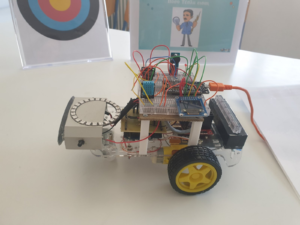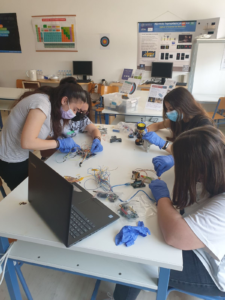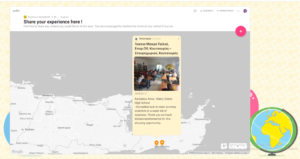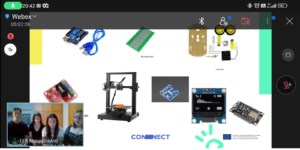News . Best Practices Aerosol… hooked on! How do you control a ‘missing crown’?

There is growing evidence that carbon dioxide levels in buildings are closely linked to the airborne spread of infections. Carbon dioxide is produced by the exhaled air of people living inside a room. The aim of the scenario is for the students to reflect on how diseases are transmitted in closed spaces, the role of CO2 and other parameters in the transport of airborne particles into them, while the ultimate goal of the scenario is for the students to develop a sensitive sensor to measure airborne particles using elements that already exist in science laboratories or that can be obtained by simple means such as Arduino microprocessors.
This good practice presents an open school education initiative, developed by GEL MACRY GIALOU and the educator Anna Karaiskou from 10/10/2021 to 1 / 5 /2022. Science scientists participated in the activities. This practice was repeated in the year 2021-2022 in another context and another structure, by the same teacher as well as the teacher Antonis Fountoulakis who are also the authors of this open scenario. This practice was previously presented HERE.
- Care: In this phase, students’ curiosity and need to upgrade their knowledge level are stimulated, pre-existing ideas are explored and prior knowledge is activated. Interest and participation is fostered through real work based on a community problem, in this case the control of COVID-19 and ways to build a sensitive sensor device. The concerns and needs related to the problem are identified and the challenges to be investigated and the affected social actors to be involved are prioritized. To engage students by inviting them to participate in a participatory research project to develop strategies for the prevention and control of Covid-19 (and other similar infectious diseases) and also to consider how it is possible to build the study device themselves. They begin by first exploring their concerns and needs with their families and then prioritizing the challenges that need to be explored. The scenario is formed based on the need for more direct communication in the classrooms without losing the sense of security. The students who took part in the activities were 15-17 year olds who were studying at the Lyceum. A total of 35 students participated in the whole process.
- Know: This phase facilitates the acquisition of knowledge and the development of the scientific skills and attitudes required to address the issues under consideration. Students used knowledge of physics, chemistry and programming. The skills the students practiced were:
- To understand how to deal with a topic-challenge that they find interesting.
- To acquire research skills
- To understand that often in a given target problem there is a conflict of interests and to realize the existence of different approaches.
- Formulate proposals-recommendations to the citizens and agencies involved
- Well-informed discussion, communication, writing, interpretation, drawing and presenting conclusions based on knowledge
- Collaboration
- Do: In this phase, students applied the knowledge and skills acquired to develop the final product assigned to them. In this case, the final product was titled “Development of a sensitive CO2 sensor for the control and protection against viruses such as SARS-CoV-2 in closed spaces”. Studies and means of achievement were summarized and shared in an open letter. A school scientific conference was organized, where groups of students presented their work and proposals to the educational community. Representatives of policy makers and other relevant bodies were invited to the conference. The project was also presented at the 4th Panhellenic Scientific Conference P.D.E. Crete in May 2022.
Conclusions on Open Schooling: Community participation in the Connect-Horizon 2022 program discussed the vital role that education plays in preparing students to collaboratively address global challenges and local issues facing humanity today, such as global warming, climate change , environmental destruction, disease, inequality and violence. Students’ contact not only with teachers but also with scientists and policy makers makes them think together and learn science to address global and local problems.
The change/innovation was supported by: [ x ] School management [ x ] school association/network
[ x ] Local government [ ] Other: ________________________________
Student results: The purpose of this Project was to create the right conditions for the students to develop a scientific way of thinking in their daily life. Low cultural familiarity with science, lack of role models, insufficient exposure to experimental methods of inquiry, as well as limited opportunities to participate in science outside of formal education lead to a lack of “scientific capital”. The solution is to add more opportunities to the curriculum for these students to learn what scientists do, talk to their families about science, and appreciate the impact of science on the world. The satisfaction level of the children after the end of the project was great as they saw their efforts rewarded, they completed the construction successfully, they met many scientists with whom they solved several problems and they communicated their results with great joy at the CONNECT conference.
This practice contributed to the increase of:
[ x ] engaging families with sciences [ x ] involving girls in science [ x ] raising awareness among students about careers in the natural sciences
Please specify: Parents participated in the collection of questionnaires for the student survey. The girls actively participated in the mapping and literature review and in general all students showed a special interest in digital maps and the contribution of geomorphological terrain to road construction.



